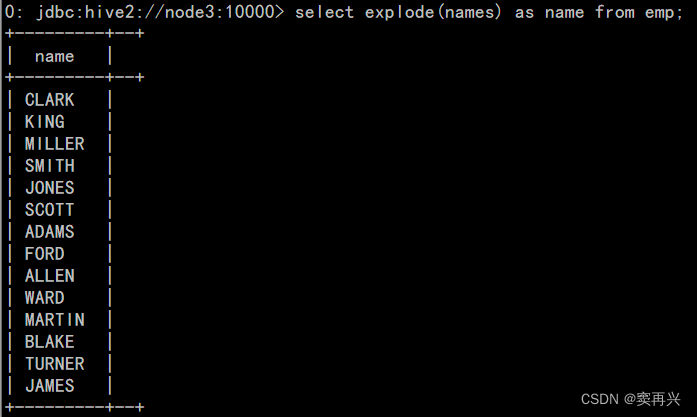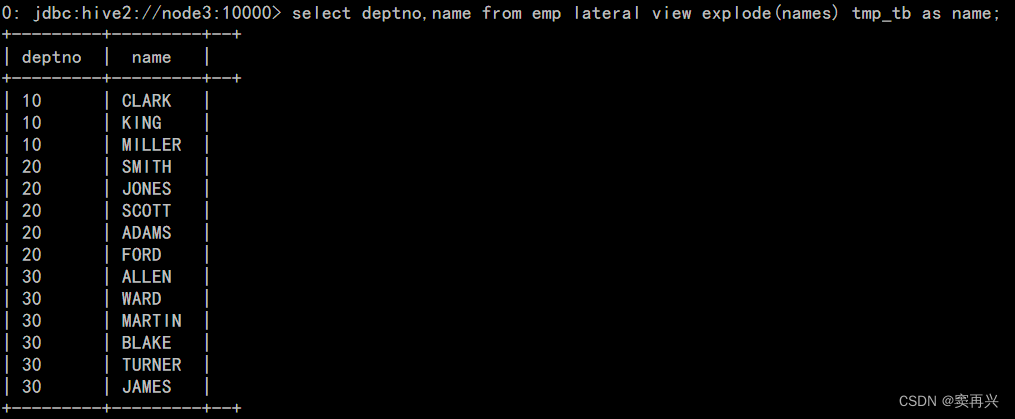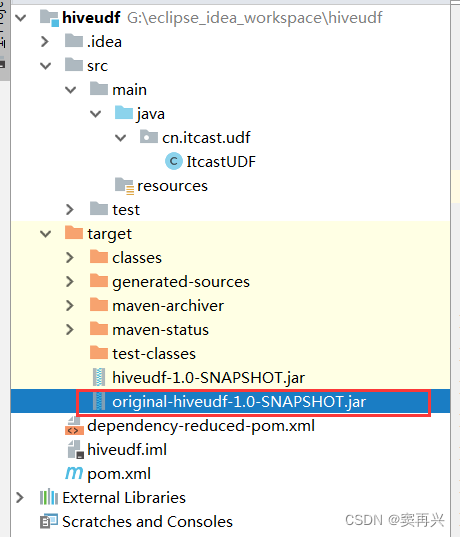目录
Hive函数
Hive的内置函数
数学函数
取整函数: round
指定精度取整函数: round
向下取整函数: floor
向上取整函数: ceil
取随机数函数: rand
幂运算函数: pow
绝对值函数: abs
字符串函数
字符串长度函数:length
字符串反转函数:reverse
字符串连接函数:concat
字符串连接函数-带分隔符:concat_ws
字符串截取函数:substr,substring
字符串截取函数:substr,substring
字符串转大写函数:upper,ucase
字符串转小写函数:lower,lcase
去空格函数:trim
左边去空格函数:ltrim
右边去空格函数:rtrim
正则表达式替换函数:regexp_replace
URL解析函数:parse_url
分割字符串函数: split
日期函数
获取当前UNIX时间戳函数:unix_timestamp
UNIX时间戳转日期函数:from_unixtime
日期转UNIX时间戳函数:unix_timestamp
指定格式日期转UNIX时间戳函数:unix_timestamp
日期时间转日期函数:to_date
日期转年函数: year
日期转月函数: month
日期转天函数: day
日期转周函数:weekofyear
日期比较函数: datediff
日期增加函数: date_add
日期减少函数: date_sub
条件函数
if函数: if
条件判断函数:CASE
条件判断函数:CASE
转换函数
cast()函数。
Hive的行转列
Hive的表生成函数
explode函数
LATERAL VIEW侧视图
LATERAL VIEW
Reflect函数
使用java.lang.Math当中的Max求两列中最大值
Hive的开窗函数
窗口函数(一) NTILE,ROW_NUMBER,RANK,DENSE_RANK
ROW_NUMBER
RANK 和 DENSE_RANK
Hive分析窗口函数(2) SUM,AVG,MIN,MAX
数据准备
SUM(结果和ORDER BY相关,默认为升序)
AVG,MIN,MAX
Hive分析窗口函数(3) LAG,LEAD,FIRST_VALUE,LAST_VALUE
准备数据
LAG
LEAD
FIRST_VALUE
LAST_VALUE
特别注意order by
Hive自定义函数
概述
自定义UDF
第一步:创建maven java 工程,导入jar包
第二步:开发java类继承UDF,并重载evaluate 方法
第三步:将我们的项目打包,并上传到hive的lib目录下
第四步:添加我们的jar包
第五步:设置函数与我们的自定义函数关联
第六步:使用自定义函数
自定义UDTF
需求
代码实现
添加我们的jar包
创建临时函数与开发后的udtf代码关联
使用自定义udtf函数
Hive函数
Hive的函数分为三类: 聚合函数、内置函数,表生成函数,聚合函数之前已经学习过了,接下来学习内置函数和表生成函数.
Hive的内置函数

数学函数
取整函数: round
语法: round(double a)
返回值: BIGINT
说明:返回double类型的整数值部分(遵循四舍五入)
举例:
| hive> select round(3.1415926); 3 |
指定精度取整函数: round
语法: round(double a, int d)
返回值: DOUBLE
说明:返回指定精度d的double类型
举例:
| hive> select round(3.1415926,4); 3.1416 |
向下取整函数: floor
语法: floor(double a)
返回值: BIGINT
说明:返回等于或者小于该double变量的最大的整数
举例:
| hive> select floor(3.1415926); 3 |
向上取整函数: ceil
语法: ceil(double a)
返回值: BIGINT
说明:返回等于或者大于该double变量的最小的整数
举例:
| hive> select ceil(3.1415926) ; 4 |
取随机数函数: rand
语法: rand(),rand(int seed)
返回值: double
说明:返回一个0到1范围内的随机数。如果指定种子seed,则会返回固定的随机数
举例:
| hive> select rand(); 0.5577432776034763 hive> select rand(); 0.6638336467363424 hive> select rand(100); 0.7220096548596434 hive> select rand(100); 0.7220096548596434 |
幂运算函数: pow
语法: pow(double a, double p)
返回值: double
说明:返回a的p次幂
举例:
| hive> select pow(2,4) ; 16.0 |
绝对值函数: abs
语法: abs(double a) abs(int a)
返回值: double int
说明:返回数值a的绝对值
举例:
| hive> select abs(-3.9); 3.9 hive> select abs(10.9); 10.9 |
字符串函数
字符串长度函数:length
语法: length(string A)
返回值: int
说明:返回字符串A的长度
举例:
| hive> select length('abcedfg')l; 7 |
字符串反转函数:reverse
语法: reverse(string A)
返回值: string
说明:返回字符串A的反转结果
举例:
| hive> select reverse(abcedfg’); gfdecba |
字符串连接函数:concat
语法: concat(string A, string B…)
返回值: string
说明:返回输入字符串连接后的结果,支持任意个输入字符串
举例:
| hive> select concat(‘abc’,'def’,'gh’);; abcdefgh |
字符串连接函数-带分隔符:concat_ws
语法: concat_ws(string SEP, string A, string B…)
返回值: string
说明:返回输入字符串连接后的结果,SEP表示各个字符串间的分隔符
举例:
| hive> select concat_ws(',','abc','def','gh'); abc,def,gh |
字符串截取函数:substr,substring
语法: substr(string A, int start),substring(string A, int start)
返回值: string
说明:返回字符串A从start位置到结尾的字符串
举例:
| hive> select substr('abcde',3); cde hive> select substring('abcde',3); cde hive>select substr('abcde',-1); e |
字符串截取函数:substr,substring
语法: substr(string A, int start, int len),substring(string A, intstart, int len)
返回值: string
说明:返回字符串A从start位置开始,长度为len的字符串
举例:
| hive> select substr('abcde',3,2); cd hive> select substring('abcde',3,2); cd hive>select substring('abcde',-2,2); de |
字符串转大写函数:upper,ucase
语法: upper(string A) ucase(string A)
返回值: string
说明:返回字符串A的大写格式
举例:
| hive> select upper('abSEd'); ABSED hive> select ucase('abSEd'); ABSED |
字符串转小写函数:lower,lcase
语法: lower(string A) lcase(string A)
返回值: string
说明:返回字符串A的小写格式
举例:
| hive> select lower('abSEd'); absed hive> select lcase('abSEd'); absed |
去空格函数:trim
语法: trim(string A)
返回值: string
说明:去除字符串两边的空格
举例:
| hive> select trim(' abc '); abc |
左边去空格函数:ltrim
语法: ltrim(string A)
返回值: string
说明:去除字符串左边的空格
举例:
| hive> select ltrim(' abc '); abc |
右边去空格函数:rtrim
语法: rtrim(string A)
返回值: string
说明:去除字符串右边的空格
举例:
| hive> select rtrim(' abc '); abc |
正则表达式替换函数:regexp_replace
语法: regexp_replace(string A, string B, string C)
返回值: string
说明:将字符串A中的符合java正则表达式B的部分替换为C。注意,在有些情况下要使用转义字符,类似oracle中的regexp_replace函数。
举例:
| hive> select regexp_replace('foobar', 'oo|ar', ''); fb |
URL解析函数:parse_url
语法: parse_url(string urlString, string partToExtract [, stringkeyToExtract])
返回值: string
说明:返回URL中指定的部分。partToExtract的有效值为:HOST, PATH, QUERY, REF, PROTOCOL, AUTHORITY, FILE, and USERINFO.
举例:
| hive> select parse_url('http://facebook.com/path1/p.php?k1=v1&k2=v2#Ref1', 'HOST'); facebook.com hive> select parse_url('http://facebook.com/path1/p.php?k1=v1&k2=v2#Ref1', 'PATH'); /path1/p.php hive> select parse_url('http://facebook.com/path1/p.php?k1=v1&k2=v2#Ref1', 'QUERY','k1'); v1 |
分割字符串函数: split
语法: split(string str, stringpat)
返回值: array
说明:按照pat字符串分割str,会返回分割后的字符串数组
举例:
| hive> select split('abtcdtef','t'); ["ab","cd","ef"] |
日期函数
获取当前UNIX时间戳函数:unix_timestamp
语法: unix_timestamp()
返回值: bigint
说明:获得当前时区的UNIX时间戳
举例:
| hive> select unix_timestamp(); 1323309615 |
UNIX时间戳转日期函数:from_unixtime
语法: from_unixtime(bigint unixtime[, string format])
返回值: string
说明:转化UNIX时间戳(从1970-01-01 00:00:00 UTC到指定时间的秒数)到当前时区的时间格式
举例:
| hive> select from_unixtime(1323308943,'yyyyMMdd'); 20111208 |
日期转UNIX时间戳函数:unix_timestamp
语法: unix_timestamp(string date)
返回值: bigint
说明:转换格式为"yyyy-MM-ddHH:mm:ss"的日期到UNIX时间戳。如果转化失败,则返回0。
举例:
| hive> select unix_timestamp('2011-12-07 13:01:03'); 1323234063 |
指定格式日期转UNIX时间戳函数:unix_timestamp
语法: unix_timestamp(string date, string pattern)
返回值: bigint
说明:转换pattern格式的日期到UNIX时间戳。如果转化失败,则返回0。
举例:
| hive> select unix_timestamp('20111207 13:01:03','yyyyMMddHH:mm:ss'); 1323234063 |
日期时间转日期函数:to_date
语法: to_date(string timestamp)
返回值: string
说明:返回日期时间字段中的日期部分。
举例:
| hive> select to_date('2011-12-08 10:03:01'); 2011-12-08 |
日期转年函数: year
语法: year(string date)
返回值: int
说明:返回日期中的年。
举例:
| hive> select year('2011-12-08 10:03:01'); 2011 hive> select year('2012-12-08'); 2012 |
日期转月函数: month
语法: month (string date)
返回值: int
说明:返回日期中的月份。
举例:
| hive> select month('2011-12-08 10:03:01'); 12 hive> select month('2011-08-08'); 8 |
日期转天函数: day
语法: day (string date)
返回值: int
说明:返回日期中的天。
举例:
| hive> select day('2011-12-08 10:03:01'); 8 hive> select day('2011-12-24'); 24 |
同样的,还有 hour,minute,second函数,分别是获取小时,分钟和秒,使用方式和以上类似,这里就不再讲述。
日期转周函数:weekofyear
语法: weekofyear (string date)
返回值: int
说明:返回日期在当前的周数。
举例:
| hive> select weekofyear('2011-12-08 10:03:01'); 49 |
日期比较函数: datediff
语法: datediff(string enddate, string startdate)
返回值: int
说明:返回结束日期减去开始日期的天数。
举例:
| hive> select datediff('2012-12-08','2012-05-09'); 213 |
日期增加函数: date_add
语法: date_add(string startdate, int days)
返回值: string
说明:返回开始日期startdate增加days天后的日期。
举例:
| hive> select date_add('2012-12-08',10); 2012-12-18 |
日期减少函数: date_sub
语法: date_sub (string startdate, int days)
返回值: string
说明:返回开始日期startdate减少days天后的日期。
举例:
| hive> select date_sub('2012-12-08',10); 2012-11-28 |
条件函数
if函数: if
语法: if(boolean testCondition, T valueTrue, T valueFalseOrNull)
返回值: T
说明: 当条件testCondition为TRUE时,返回valueTrue;否则返回valueFalseOrNull
举例:
| hive> select if(1=2,100,200) ; 200 hive> select if(1=1,100,200) ; 100 |
条件判断函数:CASE
语法: CASE a WHEN b THEN c [WHEN d THEN e]* [ELSE f] END
返回值: T
说明:如果a等于b,那么返回c;如果a等于d,那么返回e;否则返回f
举例:
| hive> select case 100 when 50 then 'tom' when 100 then 'mary'else 'tim' end ; mary hive> select case 200 when 50 then 'tom' when 100 then 'mary'else 'tim' end ; tim |
条件判断函数:CASE
语法: CASE WHEN a THEN b [WHEN c THEN d]* [ELSE e] END
返回值: T
说明:如果a为TRUE,则返回b;如果c为TRUE,则返回d;否则返回e
举例:
| hive> select case when 1=2 then 'tom' when 2=2 then 'mary' else'tim' end ; mary hive> select case when 1=1 then 'tom' when 2=2 then 'mary' else'tim' end ; tom |
转换函数
cast()函数。
公式:
cast(表达式 as 数据类型)
cast函数,可以将"20190607"这样类型的时间数据转化成int类型数据。
cast("20190607" as int)
select cast('2017-06-12' as date) filed;
Hive的行转列
1、行转列是指多行数据转换为一个列的字段。
2、Hive行转列用到的函数:
concat(str1,str2,...) --字段或字符串拼接
concat_ws(sep, str1,str2) --以分隔符拼接每个字符串
collect_set(col) --将某字段的值进行去重汇总,产生array类型字段
测试数据:
字段: deptno ename
| 20 SMITH 30 ALLEN 30 WARD 20 JONES 30 MARTIN 30 BLAKE 10 CLARK 20 SCOTT 10 KING 30 TURNER 20 ADAMS 30 JAMES 20 FORD 10 MILLER |
操作步骤
1:建表
| create table emp( deptno int, ename string ) row format delimited fields terminated by '\t'; |
2:插入数据:
| load data local inpath "/opt/data/emp.txt" into table emp; |
3:转换
| select deptno,concat_ws("|",collect_set(ename)) as ems from emp group by deptno; |
行转列,COLLECT_SET(col):函数只接受基本数据类型,它的主要作用是将某字段的值进行去重汇总,产生array类型字段。
4:结果查看

Hive的表生成函数
explode函数
explode(col):将hive一列中复杂的array或者map结构拆分成多行。
explode(ARRAY) 列表中的每个元素生成一行
explode(MAP) map中每个key-value对,生成一行,key为一列,value为一列
数据:
| 10 CLARK|KING|MILLER 20 SMITH|JONES|SCOTT|ADAMS|FORD 30 ALLEN|WARD|MARTIN|BLAKE|TURNER|JAMES |
建表:
| create table emp( deptno int, names array<string> ) row format delimited fields terminated by '\t' collection items terminated by '|'; |
插入数据
| load data local inpath "/server/data/hivedatas/emp3.txt" into table emp; |
查询数据
| select * from emp; |

使用expload查询
| select explode(names) as name from emp; |

LATERAL VIEW侧视图
LATERAL VIEW
用法:LATERAL VIEW udtf(expression) tableAlias AS columnAlias
解释:用于和split, explode等UDTF一起使用,它能够将一列数据拆成多行数据,在此基础上可以对拆分后的数据进行聚合。
列转行
| select deptno,name from emp lateral view explode(names) tmp_tb as name; |

Reflect函数
reflect函数可以支持在sql中调用java中的自带函数
使用java.lang.Math当中的Max求两列中最大值
| --创建hive表 create table test_udf(col1 int,col2 int) row format delimited fields terminated by ','; --准备数据 test_udf.txt 1,2 4,3 6,4 7,5 5,6 --加载数据 load data local inpath '/root/hivedata/test_udf.txt' into table test_udf; --使用java.lang.Math当中的Max求两列当中的最大值 select reflect("java.lang.Math","max",col1,col2) from test_udf; |
不同记录执行不同的java内置函数
| --创建hive表 create table test_udf2(class_name string,method_name string,col1 int , col2 int) row format delimited fields terminated by ','; --准备数据 test_udf2.txt java.lang.Math,min,1,2 java.lang.Math,max,2,3 --加载数据 load data local inpath '/root/hivedata/test_udf2.txt' into table test_udf2; --执行查询 select reflect(class_name,method_name,col1,col2) from test_udf2; |
Hive的开窗函数
窗口函数(一) NTILE,ROW_NUMBER,RANK,DENSE_RANK
数据准备
| cookie1,2018-04-10,1 cookie1,2018-04-11,5 cookie1,2018-04-12,7 cookie1,2018-04-13,3 cookie1,2018-04-14,2 cookie1,2018-04-15,4 cookie1,2018-04-16,4 cookie2,2018-04-10,2 cookie2,2018-04-11,3 cookie2,2018-04-12,5 cookie2,2018-04-13,6 cookie2,2018-04-14,3 cookie2,2018-04-15,9 cookie2,2018-04-16,7 CREATE TABLE itcast_t2 ( cookieid string, createtime string, --day pv INT ) ROW FORMAT DELIMITED FIELDS TERMINATED BY ',' stored as textfile;
-- 加载数据: load data local inpath '/root/hivedata/itcast_t2.dat' into table itcast_t2; |
ROW_NUMBER
ROW_NUMBER() 从1开始,按照顺序,生成分组内记录的序列
| SELECT cookieid, createtime, pv, ROW_NUMBER() OVER(PARTITION BY cookieid ORDER BY pv desc) AS rn FROM itcast_t2; |
RANK 和 DENSE_RANK
RANK() 生成数据项在分组中的排名,排名相等会在名次中留下空位
DENSE_RANK() 生成数据项在分组中的排名,排名相等会在名次中不会留下空位
| SELECT cookieid, createtime, pv, RANK() OVER(PARTITION BY cookieid ORDER BY pv desc) AS rn1, DENSE_RANK() OVER(PARTITION BY cookieid ORDER BY pv desc) AS rn2, ROW_NUMBER() OVER(PARTITION BY cookieid ORDER BY pv DESC) AS rn3 FROM itcast_t2 WHERE cookieid = 'cookie1'; |
Hive分析窗口函数(2) SUM,AVG,MIN,MAX
数据准备
| --建表语句: create table itcast_t1( cookieid string, createtime string, --day pv int ) row format delimited fields terminated by ','; --加载数据: load data local inpath '/root/hivedata/itcast_t1.dat' into table itcast_t1; cookie1,2018-04-10,1 cookie1,2018-04-11,5 cookie1,2018-04-12,7 cookie1,2018-04-13,3 cookie1,2018-04-14,2 cookie1,2018-04-15,4 cookie1,2018-04-16,4 --开启智能本地模式 SET hive.exec.mode.local.auto=true; |
SUM(结果和ORDER BY相关,默认为升序)
| select cookieid,createtime,pv, sum(pv) over(partition by cookieid order by createtime) as pv1 from itcast_t1; select cookieid,createtime,pv, sum(pv) over(partition by cookieid order by createtime rows between unbounded preceding and current row) as pv2 from itcast_t1; select cookieid,createtime,pv, sum(pv) over(partition by cookieid) as pv3 from itcast_t1; --如果每天order by排序语句 默认把分组内的所有数据进行sum操作 select cookieid,createtime,pv, sum(pv) over(partition by cookieid order by createtime rows between 3 preceding and current row) as pv4 from itcast_t1; select cookieid,createtime,pv, sum(pv) over(partition by cookieid order by createtime rows between 3 preceding and 1 following) as pv5 from itcast_t1; select cookieid,createtime,pv, sum(pv) over(partition by cookieid order by createtime rows between current row and unbounded following) as pv6 from itcast_t1; --pv1: 分组内从起点到当前行的pv累积,如,11号的pv1=10号的pv+11号的pv, 12号=10号+11号+12号 --pv2: 同pv1 --pv3: 分组内(cookie1)所有的pv累加 --pv4: 分组内当前行+往前3行,如,11号=10号+11号, 12号=10号+11号+12号, 13号=10号+11号+12号+13号, 14号=11号+12号+13号+14号 --pv5: 分组内当前行+往前3行+往后1行,如,14号=11号+12号+13号+14号+15号=5+7+3+2+4=21 --pv6: 分组内当前行+往后所有行,如,13号=13号+14号+15号+16号=3+2+4+4=13, 14号=14号+15号+16号=2+4+4=10 /* - 如果不指定rows between,默认为从起点到当前行; - 如果不指定order by,则将分组内所有值累加; - 关键是理解rows between含义,也叫做window子句: - preceding:往前 - following:往后 - current row:当前行 - unbounded:起点 - unbounded preceding 表示从前面的起点 - unbounded following:表示到后面的终点 */ |
AVG,MIN,MAX
AVG,MIN,MAX和SUM用法一样
| select cookieid,createtime,pv, avg(pv) over(partition by cookieid order by createtime rows between unbounded preceding and current row) as pv2 from itcast_t1; select cookieid,createtime,pv, max(pv) over(partition by cookieid order by createtime rows between unbounded preceding and current row) as pv2 from itcast_t1; select cookieid,createtime,pv, min(pv) over(partition by cookieid order by createtime rows between unbounded preceding and current row) as pv2 from itcast_t1; |
Hive分析窗口函数(3) LAG,LEAD,FIRST_VALUE,LAST_VALUE
准备数据
| cookie1,2018-04-10 10:00:02,url2 cookie1,2018-04-10 10:00:00,url1 cookie1,2018-04-10 10:03:04,1url3 cookie1,2018-04-10 10:50:05,url6 cookie1,2018-04-10 11:00:00,url7 cookie1,2018-04-10 10:10:00,url4 cookie1,2018-04-10 10:50:01,url5 cookie2,2018-04-10 10:00:02,url22 cookie2,2018-04-10 10:00:00,url11 cookie2,2018-04-10 10:03:04,1url33 cookie2,2018-04-10 10:50:05,url66 cookie2,2018-04-10 11:00:00,url77 cookie2,2018-04-10 10:10:00,url44 cookie2,2018-04-10 10:50:01,url55 CREATE TABLE itcast_t4 ( cookieid string, createtime string, --页面访问时间 url STRING --被访问页面 ) ROW FORMAT DELIMITED FIELDS TERMINATED BY ',' stored as textfile; --加载数据: load data local inpath '/root/hivedata/itcast_t4.dat' into table itcast_t4; |
LAG
LAG(col,n,DEFAULT) 用于统计窗口内往上第n行值第一个参数为列名,第二个参数为往上第n行(可选,默认为1),第三个参数为默认值(当往上第n行为NULL时候,取默认值,如不指定,则为NULL)
| SELECT cookieid, createtime, url, ROW_NUMBER() OVER(PARTITION BY cookieid ORDER BY createtime) AS rn, LAG(createtime,1,'1970-01-01 00:00:00') OVER(PARTITION BY cookieid ORDER BY createtime) AS last_1_time, LAG(createtime,2) OVER(PARTITION BY cookieid ORDER BY createtime) AS last_2_time FROM itcast_t4; --last_1_time: 指定了往上第1行的值,default为'1970-01-01 00:00:00' cookie1第一行,往上1行为NULL,因此取默认值 1970-01-01 00:00:00 cookie1第三行,往上1行值为第二行值,2015-04-10 10:00:02 cookie1第六行,往上1行值为第五行值,2015-04-10 10:50:01 --last_2_time: 指定了往上第2行的值,为指定默认值 cookie1第一行,往上2行为NULL cookie1第二行,往上2行为NULL cookie1第四行,往上2行为第二行值,2015-04-10 10:00:02 cookie1第七行,往上2行为第五行值,2015-04-10 10:50:01 |
LEAD
与LAG相反LEAD(col,n,DEFAULT) 用于统计窗口内往下第n行值第一个参数为列名,第二个参数为往下第n行(可选,默认为1),第三个参数为默认值(当往下第n行为NULL时候,取默认值,如不指定,则为NULL)
| SELECT cookieid, createtime, url, ROW_NUMBER() OVER(PARTITION BY cookieid ORDER BY createtime) AS rn, LEAD(createtime,1,'1970-01-01 00:00:00') OVER(PARTITION BY cookieid ORDER BY createtime) AS next_1_time, LEAD(createtime,2) OVER(PARTITION BY cookieid ORDER BY createtime) AS next_2_time FROM itcast_t4; |
FIRST_VALUE
取分组内排序后,截止到当前行,第一个值
| SELECT cookieid, createtime, url, ROW_NUMBER() OVER(PARTITION BY cookieid ORDER BY createtime) AS rn, FIRST_VALUE(url) OVER(PARTITION BY cookieid ORDER BY createtime) AS first1 FROM itcast_t4; |
LAST_VALUE
取分组内排序后,截止到当前行,最后一个值
| SELECT cookieid, createtime, url, ROW_NUMBER() OVER(PARTITION BY cookieid ORDER BY createtime) AS rn, LAST_VALUE(url) OVER(PARTITION BY cookieid ORDER BY createtime) AS last1 FROM itcast_t4; |
如果想要取分组内排序后最后一个值,则需要变通一下:
| SELECT cookieid, createtime, url, ROW_NUMBER() OVER(PARTITION BY cookieid ORDER BY createtime) AS rn, LAST_VALUE(url) OVER(PARTITION BY cookieid ORDER BY createtime) AS last1, FIRST_VALUE(url) OVER(PARTITION BY cookieid ORDER BY createtime DESC) AS last2 FROM itcast_t4 ORDER BY cookieid,createtime; |
特别注意order by
如果不指定ORDER BY,则进行排序混乱,会出现错误的结果
| SELECT cookieid, createtime, url, FIRST_VALUE(url) OVER(PARTITION BY cookieid) AS first2 FROM itcast_t4; |
Hive自定义函数
概述
Hive 自带了一些函数,比如:max/min等,但是数量有限,自己可以通过自定义UDF来方便的扩展。
当Hive提供的内置函数无法满足你的业务处理需要时,此时就可以考虑使用用户自定义函数(UDF:user-defined function)。
根据用户自定义函数类别分为以下三种:
1、UDF(User-Defined-Function)
一进一出
2、UDAF(User-Defined Aggregation Function)
聚集函数,多进一出
类似于:count/max/min
3、UDTF(User-Defined Table-Generating Functions)
一进多出
如lateral view explore()
自定义UDF
编程步骤:
(1)继承org.apache.hadoop.hive.ql.UDF
(2)需要实现evaluate函数;evaluate函数支持重载;
注意事项:
(1)UDF必须要有返回类型,可以返回null,但是返回类型不能为void;
(2)UDF中常用Text/LongWritable等类型,不推荐使用java类型;
第一步:创建maven java 工程,导入jar包
| <dependencies> <dependency> <groupId>org.apache.hive</groupId> <artifactId>hive-exec</artifactId> <version>2.7.5</version> </dependency> <dependency> <groupId>org.apache.hadoop</groupId> <artifactId>hadoop-common</artifactId> <version>2.7.5</version> </dependency> </dependencies> <build> <plugins> <plugin> <groupId>org.apache.maven.plugins</groupId> <artifactId>maven-compiler-plugin</artifactId> <version>3.0</version> <configuration> <source>1.8</source> <target>1.8</target> <encoding>UTF-8</encoding> </configuration> </plugin> </plugins> </build> |
第二步:开发java类继承UDF,并重载evaluate 方法
| public class MyUDF extends UDF{ public Text evaluate(final Text s) { if (null == s) { return null; } //返回大写字母 return new Text(s.toString().toUpperCase()); } } |
第三步:将我们的项目打包,并上传到hive的lib目录下

第四步:添加我们的jar包
重命名我们的jar包名称
| cd /export/server/hive-2.7.5/lib mv original-day_10_hive_udf-1.0-SNAPSHOT.jar my_upper.jar |
hive的客户端添加我们的jar包
| add jar /export/server/hive-2.7.5/lib/my_upper.jar; |
第五步:设置函数与我们的自定义函数关联
| create temporary function my_upper as 'cn.itcast.udf.ItcastUDF'; |
第六步:使用自定义函数
| select my_upper('abc'); |
自定义UDTF
需求
自定义一个UDTF,实现将一个任意分隔符的字符串切割成独立的单词,例如:
| 源数据: "zookeeper,hadoop,hdfs,hive,MapReduce" 目标数据: zookeeper hadoop hdfs hive MapReduce |
代码实现
| import org.apache.hadoop.hive.ql.exec.UDFArgumentException; import org.apache.hadoop.hive.ql.metadata.HiveException; import org.apache.hadoop.hive.ql.udf.generic.GenericUDTF; import org.apache.hadoop.hive.serde2.objectinspector.ObjectInspector; import org.apache.hadoop.hive.serde2.objectinspector.ObjectInspectorFactory; import org.apache.hadoop.hive.serde2.objectinspector.StructObjectInspector; import org.apache.hadoop.hive.serde2.objectinspector.primitive.PrimitiveObjectInspectorFactory; import java.util.ArrayList; import java.util.List; import java.util.function.ObjDoubleConsumer; public class MyUDTF extends GenericUDTF { private final transient Object[] forwardListObj = new Object[1]; @Override public StructObjectInspector initialize(StructObjectInspector argOIs) throws UDFArgumentException { //设置列名的类型 List<String> fieldNames = new ArrayList<>(); //设置列名 fieldNames.add("column_01"); List<ObjectInspector> fieldOIs = new ArrayList<ObjectInspector>() ;//检查器列表 //设置输出的列的值类型 fieldOIs.add(PrimitiveObjectInspectorFactory.javaStringObjectInspector);
return ObjectInspectorFactory.getStandardStructObjectInspector(fieldNames, fieldOIs); } @Override public void process(Object[] objects) throws HiveException { //1:获取原始数据 String args = objects[0].toString(); //2:获取数据传入的第二个参数,此处为分隔符 String splitKey = objects[1].toString(); //3.将原始数据按照传入的分隔符进行切分 String[] fields = args.split(splitKey); //4:遍历切分后的结果,并写出 for (String field : fields) { //将每一个单词添加值对象数组 forwardListObj[0] = field; //将对象数组内容写出 forward(forwardListObj); } } @Override public void close() throws HiveException { } } |
添加我们的jar包
将打包的jar包上传到node3主机/export/server/hive-2.7.5/lib目录,并重命名我们的jar包名称
| cd /export/server/hive-2.7.5/lib mv original-day_10_hive_udtf-1.0-SNAPSHOT.jar my_udtf.jar |
hive的客户端添加我们的jar包,将jar包添加到hive的classpath下
| hive>add jar /export/server/hive-2.7.5/lib/my_udtf.jar |
创建临时函数与开发后的udtf代码关联
| hive>create temporary function my_udtf as 'cn.itcast.udf.ItcastUDF'; |
使用自定义udtf函数
| hive>select myudtf("zookeeper,hadoop,hdfs,hive,MapReduce",",") word; |



















第TR5周:Transformer中的位置编码详解)